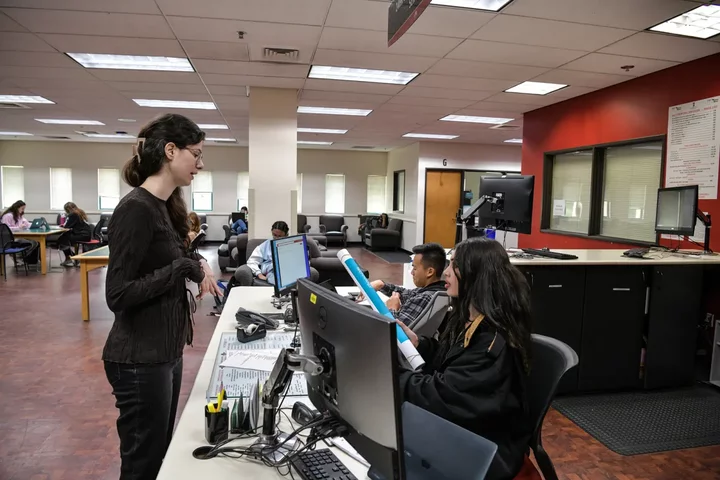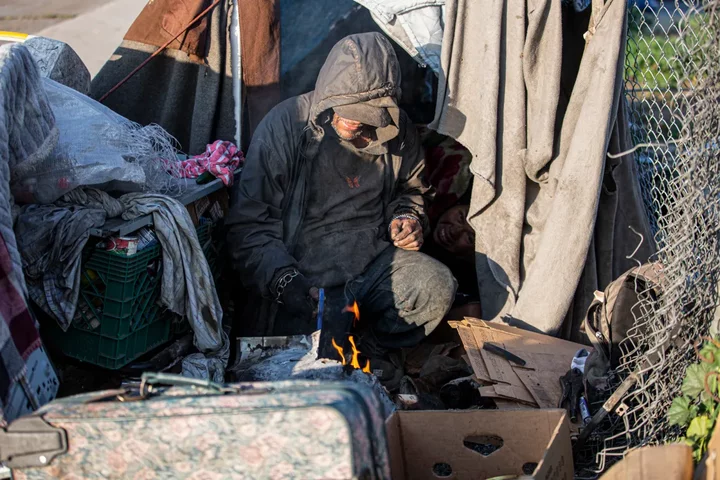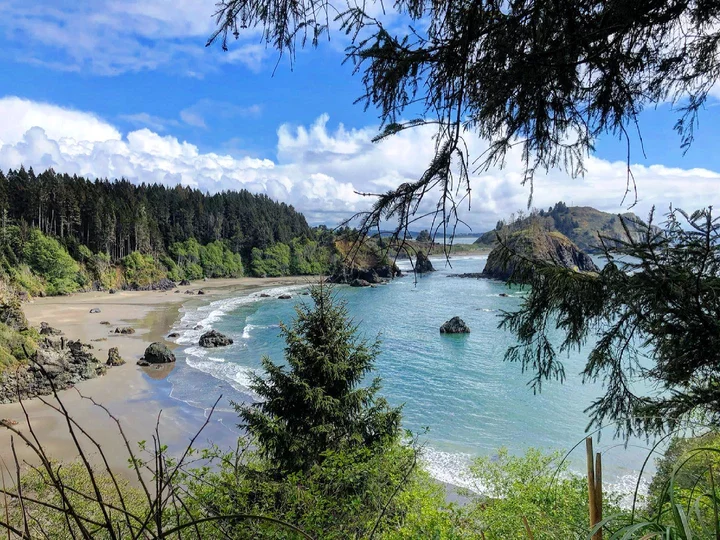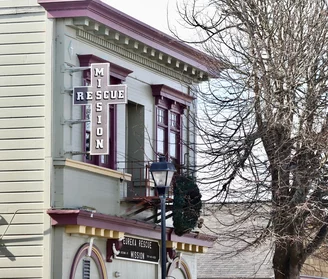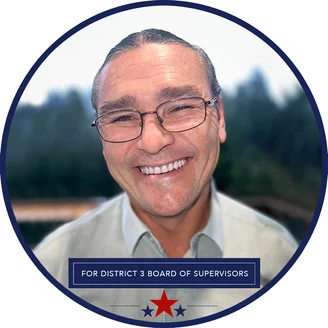Cal State Student Workers Voted to Form a Union. Here’s What Students Want.
LoCO Staff / Thursday, Feb. 29, 2024 @ 7:52 a.m. / Sacramento
Delilah Mays-Triplett works from her work station as a student assistant inside the Love Library Edition at San Diego State University in San Diego on April 12, 2023. Photo by Pablo Unzueta for CalMatters
Delila Grubaugh wasn’t sure if joining a union would benefit her. That is, until she contracted pneumonia and found herself unable to get paid sick leave, forcing her to work her library assistant job at Cal State Fullerton while ill. Access to paid sick leave is why Grubaugh, a third year communications major, joined student workers across the Cal State system who voted yes to a union.
Among the 20,000 student assistants working in the system, 7,750 cast a ballot, with 7,050 voting yes to a union, according to results released by the CSU Employees Union Feb. 23. Priorities for student assistants include paid sick leave, affordable parking, an increased cap on working hours and fair wages.
Student workers like first-year sociology and political science student Maddux Erkerling, who works as an assistant for the Jewish Studies Department at San Francisco State, rely on their jobs to pay for college expenses, including housing. Studying and working in an expensive area makes this especially difficult.
“I was working two jobs last semester, and was still about $200 to $300 short on my rent every month,” said Erkerling, who also works as an organizer for the union. “I had to rely on scholarships just to pay my rent and food bills.”
Last semester, Erkerling contracted COVID-19, costing him $600 in lost wages. While Erkerling acknowledges that he is “very grateful” for the community at his workplace, he said many students are pressured to work while sick because they need the money.
The recent unionization efforts of Cal State undergraduates follows last year’s University of California graduate student worker’s strike where over 36,000 employees campaigned for benefits like increased wages, anti-bullying protections, maternity leave and transit passes. The strike ended after two months of protests and bargaining between the UC graduate students and university officials.
Paid sick leave is one of the main points that the union emphasized in its campaign. Since last October, campus organizers have been urging the 20,000 student workers to vote to join the 16,000 members of the CSU Employees Union. In a press release, Catherine Hutchinson, the president of the employee union, encouraged students to unite to fight for better working conditions and fair pay. “Student work is real work,” said Hutchinson in the release.
Cal State spokesperson Amy Bentley-Smith referred to Vice Chancellor for Human Resources Leora Freedman’s statement as the system’s official response to the union vote, noting the “long history of providing on-campus jobs to students through student assistant positions” and that the Cal State system “looks forward to bargaining in good faith.”
“Some student workers earn less than their local minimum wages. We want to negotiate for better wages.”
— Cameron Macedonia, a fourth-year student at Cal State Fullerton and union organizing intern
For some students, their job is more than work — it’s an opportunity to gain experience early in their careers. Zoe Flohr, a senior psychology and sociology major at Cal State Bakersfield, said being a student assistant gives her insight into what it is like to be a professor. As a teaching assistant, Flohr holds office hours and study sessions, helps create exams, grades assignments and quizzes and responds to student questions through email or Canvas.
Flohr said her main priorities for the union are better working conditions in addition to higher pay, increased work hours to 30 a week, and opportunities to work on weekends.
“I think it depends on the student, like how many classes they’re taking and how often they’re on campus, but since the price of rent is increasing, the students want to be able to work more than their 20-hour limit,” said Flohr.
According to union organizing intern Cameron Macedonia, a fourth-year student at Cal State Fullerton, fair wages and lower parking costs have also been priorities for student workers. Faculty and staff typically pay lower parking rates than students.
“A majority of our students make minimum wage and the university actually isn’t even required to pay local minimum wage,” Macedonia said. “So some student workers earn less than their local minimum wages. We want to negotiate for better wages. We want to negotiate for affordable parking.”
On the day the vote result was announced, student organizers celebrated. Next, the work begins. The union and Cal State officials will meet to negotiate a contract, though exact dates have not been set.
“Right now, the next steps are to get a bargaining team of students and student workers together and meet with the CSU to sit at the same table as them for, like, the first time in history, ” Macedonia said.
###
Barahona, Chkarboul, Munis and San Roque are fellows with the CalMatters College Journalism Network, a collaboration between CalMatters and student journalists from across California. CalMatters higher education coverage is supported by a grant from the College Futures Foundation.
CalMatters.org is a nonprofit, nonpartisan media venture explaining California policies and politics.
BOOKED
Today: 5 felonies, 18 misdemeanors, 0 infractions
JUDGED
Humboldt County Superior Court Calendar: Today
CHP REPORTS
US101 N / CRANNELL RD OFR (HM office): Trfc Collision-Minor Inj
ELSEWHERE
100% Humboldt, with Scott Hammond: #88. From Queens to Humboldt: Larry Goldberg’s Journey
RHBB: Butler Fire Spreads to 15,663 Acres with 2% Containment
RHBB: Driver Strikes Two Parked Vehicles in Rio Dell
Study Finds: Why Americans Keep Gaining Weight Despite Burning More Calories Than Ever
It’s Now Significantly More Deadly to Be Homeless. Why Are So Many People Dying?
Marisa Kendall / Thursday, Feb. 29, 2024 @ 7:48 a.m. / Sacramento
A man starts a fire in his makeshift tent along a barbed wire fence near Highway 99 in southwest Fresno on Feb. 11, 2022. The fence blocks out a grass area that used to be a homeless encampment. Photo by Larry Valenzuela for CalMatters.
For many people, living on the streets of California is a death sentence.
That’s according to a recent study that took the first deep look into mortality rates in homeless communities throughout the country. It found the death rate more than tripled between 2011 and 2020. The findings make it clear that at the same time the number of homeless Californians is soaring, it’s also becoming more dangerous to be homeless. And it means the stakes are sky-high when it comes to state and local efforts to combat the crisis: People’s lives are on the line.
The study’s co-author, Matthew Fowle of the University of Pennsylvania, said the 238% increase was “astonishing.”
“It’s unlike any other mortality trend that we really see in demography,” he said. “It’s comparable to something like a natural disaster or war.”
Overdoses played a major role in the deaths studied. But people also are dying at increased rates of things that might be avoided if they had a home or regular access to preventative medical care, such as heat and cold exposure, traffic injuries, cardiovascular disease and diabetes.
“It’s just so hard to do that when you’re living on the streets or living in a shelter,” Fowle said. “Your main concern is, ‘Can I stay warm and dry for the night? Can I get enough food to eat?’ You can’t think about these other longer-term things that might be affecting your health until, in many cases, it’s too late.”
Some of the increase in the mortality rate may be attributable to county death records keeping better track of who is homeless, Fowle said. Other than that, he and his team aren’t sure what else is behind the rising death rates — more research is needed, he said.
“Clearly something is occurring across the country,” Fowle said.
The study, published this month in health policy research journal Health Affairs, appears to be the first to look at death rates and causes of death in homeless communities nationwide. Data on this subject is spotty, as the feds and most states (including California) don’t require medical examiners to list someone’s housing status in their death records. Fowle’s study looked at 22,143 deaths of homeless residents in 22 localities across 10 states and Washington, D.C. — including eight California counties. The death rate across all 22 localities increased from 814 per 100,000 homeless residents in 2011, to 2,752 per 100,000 homeless residents in 2020.
Among the general population, the nationwide mortality rate was much lower: 1,027 deaths per 100,000 people in 2020, according to the Centers for Disease Control and Prevention.
In California, the study looked at Alameda, Los Angeles, Orange, Sacramento, San Diego, San Mateo, Santa Clara and Solano counties. In those counties, the mortality rate more than doubled between 2015 and 2020. Some of those counties didn’t start collecting data until 2015.
Like most information on unhoused populations, the data has limitations. For example, it uses mortality rates based on the federally mandated point-in-time population counts, which are inexact estimates of the country’s homeless communities.
Nationwide, drug and alcohol overdoses were the leading cause of fatalities, accounting for nearly a third of all deaths. Overdoses caused 986 deaths per 100,000 unhoused people in 2020, a 488% increase from 2011.
The opioid crisis and the increased prevalence of fentanyl played a huge role in those numbers, said Fowle, a postdoctoral fellow at the University of Pennsylvania’s Housing Initiative at Penn. But deaths also may be driven by new efforts throughout California and beyond to crack down on people sleeping in public places, he said. When people use drugs in a homeless encampment surrounded by people they know and trust, or even alone on a busy downtown street, there’s a greater chance someone will see them and intervene if they overdose. If law enforcement breaks up their camp and pushes them out of downtown, they often go to isolated areas such as creek beds, where they’re harder to help in an emergency.
When someone is displaced from their camp, they also become less able to access a safe supply of drugs — putting them at greater risk for consuming something laced with fentanyl, said Dr. Margot Kushel, director of the UCSF Benioff Homelessness and Housing Initiative.
Another reason being homeless has become more deadly? The homeless population is getting older, Kushel said.
The number of Californians 55 and older who sought homelessness services soared 84% between 2017 and 2021, according to the state’s Homeless Data Integration System. That’s compared to a 43% increase across all age groups. People become homeless for the first time after age 50 with more frequency now.
“As the homeless population continues to age, you’re just going to see death rates keep going up and up and up,” Kushel said. “You expect that, and it’s horrendous.”
The average age of death in the University of Pennsylvania study was 51 — more than 27 years younger than the average U.S. life expectancy during that time period.
Deaths attributed to cardiovascular disease, the second-leading cause of death, increased 172% between 2011 and 2020. Other causes that saw major increases include diabetes, infection, cancer, homicide and exposure.
Being homeless is incredibly bad for your health, Kushel said. As soon as someone loses their housing, everything else starts to fall apart. Drug use tends to get worse, people lose the medication that treats their chronic illnesses, and they don’t go to the doctor for preventative care because they’re too busy worrying about where they’ll sleep or what they’ll eat. That means something like a small infection can turn life-threatening quickly.
“It’s unlike any other mortality trend that we really see in demography. It’s comparable to something like a natural disaster or war.”
— Matthew Fowle, postdoctoral fellow, University of Pennsylvania Housing Initiative
And once someone is diagnosed with a serious illness, treatment is much harder on the street. A recent study of veterans with cancer, co-authored by Kushel, found that those without housing were 10% to 20% more likely to die than those with housing. Even for veterans who started out homeless during the study, once they found housing, their risk of dying plummeted.
“There is increasing evidence that you can prevent a lot of these deaths just by getting people housed,” Kushel said.
Clinicians who treat people on the street are watching in real time as conditions for their patients become more deadly. Whenever outreach workers call Dr. Susan Partovi, medical director of Homeless Health Care Los Angeles and author of the memoir Renegade MD, the first thing she asks is “Who died?”
All too often, it’s someone she knew.
“It’s really heartbreaking,” she said, “when you know someone, and you know their humor, and you know their dreams, and you know their past history, and you know their ups and downs in life…And you’re kind of in the trenches with them and their struggles. And then they die. It’s just so disheartening. It’s just so sad.”
###
CalMatters.org is a nonprofit, nonpartisan media venture explaining California policies and politics.
OBITUARY: George Head, 1937-2024
LoCO Staff / Thursday, Feb. 29, 2024 @ 6:56 a.m. / Obits
Our
dad, George Head, died peacefully February 23, 2024, on what would
have been his and our mom’s 66th wedding
anniversary.
Dad was born on November 26, 1937, to George Head and Clara (Ambrosini) Head. Dad graduated from Fortuna High School in 1955, and yes, he wore Levi’s cuffed at the bottom and had a pack of cigarettes rolled in the sleeve of his white T-shirt. Mom and Dad were married in 1958. They welcomed twins, Tom and Lisa, in 1959. Two years later they welcomed another son, James, and after a long stretch of seven years, another girl, Jennifer, was born. Dad worked for his father at the Head family furniture store before going to work for the Pacific Lumber Company. He retired in 1998.
In his free time, Dad could be found wherever the fish were biting. He was always on Ruth Lake right before sunup. Just as other fishermen were launching their boats, Dad would be pulling his boat out of the water with his limit of fish. Besides fishing, Dad enjoyed deer hunting and spending time with family at our cabin in Dinsmore. Other pastimes included coffee with friends at local coffee shops around Fortuna, where together they would discuss and solve the town’s problems.
Dad served in the Fortuna Volunteer Fire Department for 50 years. He later served as a Fire Commissioner for the department.
Dad amazed us all in June of 2007. He had a massive heart attack and the doctor told us he only had one to three hours to live. He was released from the hospital and led a fulfilling life for 17 more years.
Dad was preceded in death by his parents, George Head and Clara Ambrosini-Allen, his in-laws Percy and Dorothy Poe, his wife Sandra, and his sister Diane Senestraro. He is survived by his sister, Darlene Calvert; Children, Thomas Head (Lori), Lisa Broadstock (John), James Head and Jennifer Lourenzo (Tim); Grandchildren; Brandon Head (Miranda), Bryce Head (Trisha), Bryant Head (Halie), Christopher Broadstock (Sami), Rusty Broadstock (Jen), Tanner Broadstock (Meghann), Alisha Head, Steven Head, Jenna Mendiburu (Mike), Cale Lourenzo, and Emily Lourenzo (Jordan). Additionally, Dad had 20 great-grandchildren and one more on the way.
We will remember Dad for his generosity, wisdom, and keen sense of humor.
Graveside services for family and close friends will be held Monday, March 4 at 1 p.m., at Sunrise Cemetery, 3315 Newburg Road, Fortuna. Everyone is invited to join us afterwards from 1:30-3:30 p.m., for Dad’s favorite meal, dessert, at the Gene Lucas Center, 3000 Newburg Road, Fortuna.
Arrangements have been made through Goble’s Fortuna Mortuary.
Donations in Dad’s name, can be made to the American Heart Association or a charity of your choice.
###
The obituary above was submitted on behalf of George Head’s loved ones. The Lost Coast Outpost runs obituaries of Humboldt County residents at no charge. See guidelines here.
College Cove Will Be Closed Intermittently Throughout March and April to Accommodate Trail Restoration
LoCO Staff / Wednesday, Feb. 28, 2024 @ 2:42 p.m. / News
College Cove on a sunny Humboldt day. Image via California State Parks.
###
Press release from California State Parks:
Trinidad, Calif.— In the interest of public safety and resource protection, College Cove will be closed to access and use on March 7th-12th, March 21st-26th, April 4th-9th, and April 18th-23rd, 2024. This closure is necessary for public safety while crews work on trail restoration. The temporary closure order will apply to the parking area and trail within the unit.
With the exception of park employees and approved contractors, no person shall be in the above-mentioned closure area for any reason, day or night during the times listed. Authorized emergency vehicles, Department of Parks and Recreation personnel, vehicles, and equipment required to perform the restoration work are exempt from this Order.
###
Who Wants to Adopt a Wild Mustang or Burro? BLM to Offer Critters, Incentives at Humboldt County Fairgrounds
LoCO Staff / Wednesday, Feb. 28, 2024 @ 2 p.m. / Animals
###
Press release from the Bureau of Land Management:
Ferndale – The Bureau of Land Management will offer two untrained Mustang yearling fillies and four wild burros for adoption Saturday, March 9, at the Humboldt County Fairgrounds in Ferndale.
Anyone interested can see the available animals between noon and 5 p.m., Friday, March 8. The adoption begins with a silent auction at 9 a.m. Saturday. Animals not taken during the auction will be available on a first come, first served basis for a $125 adoption fee. The BLM’s Adoption Incentive Program applies to this event; adopters receive a check for $1,000, when they receive title to their animals a year after adoption.
To qualify, adopters must be at least 18 years old and have facilities that meet the BLM’s requirements. Title to the animals remains with the federal government for a year, after which adopters can apply for title. Detailed information about adopter qualifications and facility requirements can be found online.
The adoption event is being held in conjunction with the Back Country Horsemen of California Trail Obstacle Challenge, a free event for spectators. The event includes demonstrations on back country horse and burro packing topics, including Dutch oven cooking, predator encounters, trail etiquette and correctly packing gear.
The BLM is responsible under the Wild Free Roaming Horses and Burro Act for protecting and managing wild horses and burros on public lands. The agency periodically removes animals from the range when populations exceed levels established to allow wild horse and burro herds to thrive in balance with other range users, including wildlife and permitted livestock. These animals are then available for adoption at events throughout the country.
To learn more about the BLM’s Wild Horse and Burro program, please visit: https://www.blm.gov/whb.
In This Time of Cold and Rainy Weather, the Rescue Mission Could Use Some Help
Hank Sims / Wednesday, Feb. 28, 2024 @ 1:09 p.m. / Homelessness
It’s been cold as hell the last few nights and there’s more rain coming soon. That means the Eureka Rescue Mission has been very busy.
Yesterday, the Mission’s operation manager put out a call on social media, in the Humboldt County On Alert Facebook group. He wrote:
We are in need of essential items like brown rice, white rice, pinto beans, macaroni, milk, eggs, cheese, butter, bologna, ham, turkey, and black tea. Your donations, big or small, make a significant impact. If you’re able to contribute, please drop off items at the Eureka Rescue Mission at 110 2nd St in Old Town.
Reached this morning, the Rescue Mission’s executive director, Bryan Hall, confirmed that they’ve been putting up a lot of people lately, and while they’re not yet in crisis mode as far as the state of their pantry is concerned, some donations of the items mentioned would be very helpful right now, especially with the mission housing 50 women and children and up to 80 men a night.
“It’s not that we’re desperate right now, but we always have a need,” Hall said.
Got some rice or beans or pasta or dairy or eggs or lunchmeat you can part with? Hall said that you can drive them up to the Rescue Mission — 100 Second Street — anytime. There’ll be people there to help you unload, if you like.
Also, of course, the Mission is more than happy to take any monetary donation you might have to offer. There’s a handy donation link on their website. Also, you can phone the Mission’s main line — (707) 445-3787 — and ask for Carol. She’ll help you help them in any way you like.
Gomez Campaign for County Supervisor Files Overdue Financial Disclosure Forms
Ryan Burns / Wednesday, Feb. 28, 2024 @ 12:24 p.m. / Elections
Rogelio “Roy” Gomez’s campaign for county supervisor submitted overdue financial disclosure forms to the county elections office on Monday, the same day that the Outpost asked for details about the campaign’s fundraising efforts to date.
Gomez is challenging incumbent Mike Wilson for the Third District seat on the Humboldt County Board of Supervisors.
As we reported Monday, the Gomez campaign previously filed a Form 470, which is for candidates who don’t intend to raise and/or spend $2,000 or more. This despite the fact that his campaign announced in December that it was in “full campaign fundraising mode,” was soliciting donations via PayPal and had professionally designed yard signs.
Asked for confirmation that the campaign had not raised or spent more than $2,000, campaign manager Jessica Gomez (Roy’s wife) replied via Facebook Messenger, saying they would not answer any questions about “campaign fundraising, advertisements, or any other information regarding our campaign” unless the Outpost first reported on Eureka City Councilmember G. Mario Fernandez’s interest in anarchism.
The Gomezes have made impassioned public comments on this issue at Eureka council meetings and elsewhere, theorizing that a majority of the five-person council may have infiltrated city government in order to dismantle it from within:
At some point on Monday (employees at the Elections Office couldn’t say exactly when), the Gomez campaign turned in a 470 amendment form disclosing that it had, in fact, exceeded the $2,000 fundraising threshold, with an explanatory note saying, “some funds still on hold by paypal.”
The campaign also submitted a Form 410, disclosing the formation of a recipient committee, “Elect Roy Gomez,” which is required of campaigns that exceed the $2,000 mark. The data entered on that form says that the Gomez campaign reached the qualification threshold five days earlier, on Feb. 21.
According to the Fair Political Practices Commission’s campaign manual for local candidates, “A committee that qualifies during the last 16 days before the election must file Form 410 within 24 hours of qualifying.”
We reached out to the Gomez campaign via Facebook Messenger to ask about the discrepancy, and though our message was “seen” by the page manager a little before 10 a.m., no one from the campaign responded before the time this post was published. We will update if we get a response.
Jay Wierenga, communications director for the FPPC, told the Outpost that while any violation of California’s Political Reform Act can carry a penalty of up to $5,000, the commission considers such things on a case-by-case basis, with leeway given for mitigating factors such as lack of experience from first-time candidates.
Election Day is next Tuesday, March 5.

